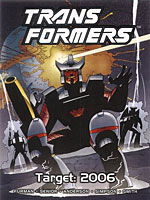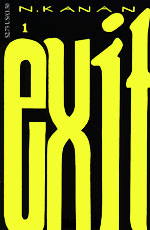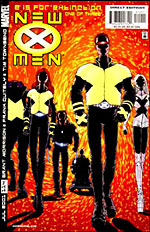>> Top Nine: O'Brien's Choice
>> Article 10: Arts From Their Elbows
More...

Writer and reviewer Paul O'Brien has been Ninth Art's lead essayist from the start, and a lynchpin contributor to the site, providing some of the most intelligent commentary on the comic industry you're ever likely to find, via his fortnightly column Article 10. His wry analysis has helped set the debate for the past five years, and the column has consistently proved one of the site's biggest attractions. Paul also writes regular weekly reviews of the x-titles and other comics at The X-Axis, and maintains a non-comics review blog, If Destroyed.
TRANSFORMERS: TARGET 2006
Simon Furman, Geoff Senior, Jeff Anderson, Will Simpson and Tim Perkins
 Now, let's be clear about the ground rules here. This is not a list of the best nine comics, in my opinion or otherwise. Critics' 'best of' lists are invariably boring and just end up with the usual suspects winning - CITIZEN KANE, PET SOUNDS, WATCHMEN. This is a purely subjective list and it's subject to revision at my slightest whim.
Now, let's be clear about the ground rules here. This is not a list of the best nine comics, in my opinion or otherwise. Critics' 'best of' lists are invariably boring and just end up with the usual suspects winning - CITIZEN KANE, PET SOUNDS, WATCHMEN. This is a purely subjective list and it's subject to revision at my slightest whim.
Nonetheless, it'd be a strange day when Simon Furman's run on TRANSFORMERS failed to make the list. This tends to confuse Americans, since their version was by Bob Budiansky and ranged from mediocre to thunderously awful. And it's not like Simon Furman and Geoff Senior went on to become big name creators, like the guys over at 2000AD.
But it doesn't matter, because the UK version of TRANSFORMERS was a genuinely good kids' action series that showed far more effort than the material really merited. Every year Furman would wrestle with another ludicrous curveball - a bunch of new characters with transforming heads, a plotline in the American series that contradicted everything he was doing - and still came out of it with great entertainment. TARGET 2006, a tie-in to the 1986 animated movie, is perhaps the best example of the British title taking a deeply unpromising start and turning it into something legitimately epic and memorable.
This is not, strictly speaking, the title that got me into comics. That would probably be the 1980s version of EAGLE. But I don't really remember anything about EAGLE, whereas TRANSFORMERS sticks in the mind. It's also, crucially, an introduction to the American style of comics - longer stories on a bigger scale - and has more in common with the books I went on to read.
NEW MUTANTS #50
Chris Claremont, Jackson Guice and John Beatty
I could list the first American import comic I bought, but that was WEB OF SPIDER-MAN #17, and frankly, I can't remember anything else about it. I could list the first X-book I bought, but that was X-FACTOR #2, and I didn't touch the series again for a couple of years. Or I could list the first genuinely credible comic I bought, which was DAREDEVIL #231 (part four of "Born Again"), but it's not a great jumping-on point for an eleven year old and it left me completely cold.
No, it's not until the next year and NEW MUTANTS #50 that somebody finally hooked me as a repeat customer. In theory this isn't a very good jumping on point either - it's the culmination of a strange storyline involving time travel, techno-organic monsters, and space opera - but it dangles interesting concepts in front of you and makes you want to come back and learn more about them. Bearing in mind that this involved hunting down the handful of newsagents that actually stocked imported comics - until I worked out that Edinburgh did actually have a comics store, tucked away on a cobbled lane and uninformatively named "The Science Fiction Bookshop" - this actually required a degree of effort, so it must have been a good issue.
I haven't re-read this issue in ages, and I don't really want to, because I was twelve when it came out, and I suspect it might not have aged very well.
SHADE THE CHANGING MAN #1-50
Peter Milligan and Chris Bachalo
We're jumping forward to the mid-to-late teens, and my pet favourite Vertigo title. Oh, sure, SANDMAN gets all the trade paperback sales, and DOOM PATROL is weirder, but Peter Milligan and Chris Bachalo's literally insane take on Shade, the Changing Man was a fantastically bizarre comic in its own right, and unfairly overshadowed by its brethren. It doesn't help, of course, that DC kept it out of print for years, and that it goes badly downhill after the dominant storyline finishes in issue #50 - which, in retrospect, would have been a good time to cancel it. But for those first few years, this was a gloriously unique book, following its own peculiar yet compelling internal logic. It's got such a strong sense of identity that it always leapt off the shelves. It also features, for my money, far and away the best art of Chris Bachalo's career, when he was delivering compelling images without losing sight of the need to tell the story.
Okay, ENIGMA is probably slightly better. Other Vertigo books are more influential. But SHADE is the one that sticks in my mind, and makes the list.
EXIT
Nabiel Kanan
 This mid-90s indie curio was award-nominated in its day, but seems to have largely disappeared from memory. But Antony Johnston already put it on his list, so it's clearly not as obscure as all that. A small press English book that ran for two very short series, EXIT was your basic slice-of-life teen drama, notwithstanding a token thriller plot. It's about kids leaving school and wondering what they're going to do with their lives, and it's the first non-genre comic to really capture my attention.
This mid-90s indie curio was award-nominated in its day, but seems to have largely disappeared from memory. But Antony Johnston already put it on his list, so it's clearly not as obscure as all that. A small press English book that ran for two very short series, EXIT was your basic slice-of-life teen drama, notwithstanding a token thriller plot. It's about kids leaving school and wondering what they're going to do with their lives, and it's the first non-genre comic to really capture my attention.
It helps, of course, that the book was visually compelling. Kanan's black and white art (and that's just black and white, no ziptone or shading) is striking without being overly stark, and the covers displayed a sense of design that puts 99% of comics - indie or otherwise - to shame. While most covers scream for attention, Kanan's stand out by being so stubbornly peaceful.
Come to think of it, I haven't heard much about Nabiel Kanan since he published THE BIRTHDAY RIOTS five years ago. Apparently he's working on something called THE DROWNERS at the moment, which I'm now feeling slightly guilty for not having read.
HATE
Peter Bagge
The acceptable face of Fantagraphics. Yes, yes, I know they're vital to the development of the industry and all that, but they always come across to me as the comic book equivalent of the guy in the record store who thinks customers are only worth his time if they have a working knowledge of Moroccan bazouki music and a comprehensive set of Led Zeppelin live albums. They might well be right, but you really can't be bothered finding out.
Peter Bagge's HATE is about as far as you can get from Fantagraphics' public image without actually including a superhero. It's also got one of the most misleading titles in history, since there wasn't much hate in it at all. Buddy Bradley was more of a slacker who ultimately ends up as a basically responsible small businessman, and the tone of the book is more cynical and frustrated than hateful. Although Bagge still puts out an issue annually - which at least puts it on a more regular schedule than APOCALYPSE NERD - it was very much a comic of its time, complete with grunge-era Seattle setting.
Despite that, it's aged surprisingly well. The stories and character comedy are universal enough to endure, while the setting meant that it captured the zeitgeist when it came out. Bagge's probably going to spend the rest of his career in the shadow of HATE, but there are worse problems to have.
THE OFFICIAL HANDBOOK OF THE MARVEL UNIVERSE
Mark Gruenwald and Peter Sanderson
Technically not a comic at all, but I don't care. Things really don't come much more geeky than the 1980s HANDBOOK, which solemnly catalogued the main characters of the Marvel Universe over the course of a fabulously excessive ten volumes of trade paperback. (The recent Essentials reprint has squashed them into three, including the missing Appendix.) Obviously on one level it's an absurd publication, but in saying that, it's easy to miss the point.
First of all, the appeal of the Marvel and DC Universes is in some ways rather similar to that of Tolkein or STAR WARS. It's not so much the individual stories as the cohesive world they build. That cohesion is important, even to a casual reader, as a key part of the entertainment. Obviously there are some points of continuity that are too trivial to matter, because only a tiny proportion of the audience will spot the problem. But the sense of a coherent world is important, and central to the appeal of many superhero comics. And nothing sums it up better than the HANDBOOK.
Secondly, the HANDBOOK writers know a lot of this stuff is silly, and they also know that the original creators knew it too. It's not the work of grim-faced continuity buffs trying to lay down the law, but a celebration of the genre. This is what gives the original HANDBOOK its curious appeal, and distinguishes it from the charmless regurgitation of trivia practiced by the current version.
VIZ
Various
It's all too easy to get caught up in the comics bubble, which can give you a very warped perspective on the world. Comedy anthologies tend to be talked about as though they come from a parallel universe, off to the side somewhere, that doesn't really count. With VIZ, at least, the opposite was true. A legitimate mainstream phenomenon, in its heyday the book was regularly selling a million copies in the UK alone, making it not merely Britain's top-selling comic, but Britain's top-selling magazine of any sort. Sales long since declined from that peak, but the title still far outperforms any 'real' comic.
The recipe is hard to pin down, since it relies on a combination of surrealism, satire, parody, and fart jokes. It probably wouldn't translate for an American audience, since the format depends on you recognizing the style of British kids' comics. But at its peak, VIZ was inventive, clever, and extremely funny. To be honest, it's still pretty good today, only suffering in comparison with itself. It's been years since I've bought it regularly, admittedly, but it remains the great mainstream breakthrough comic that the medium spectacularly failed to capitalise upon - because all they did was churn out third-rate clones.
VIZ tends to be ignored in comics discussions, perhaps because it doesn't fit the grand narrative about what the mainstream audience supposedly want. But it ought to be paid more attention, if we're genuinely interested in the whole medium.
NEW X-MEN #114-154
Grant Morrison and various artists
 Oh, come on, you knew it was coming. I've written about this book at great length in the past, so I'll keep it short here. This is the Grant Morrison run, obviously. Now, I'm not an uncritical supporter of Morrison's work; personally, I think INVISIBLES is wildly overrated, and his JLA run was dodgy. And this book is far from flawless - it's got highly erratic art, plus a final arc that really doesn't work.
Oh, come on, you knew it was coming. I've written about this book at great length in the past, so I'll keep it short here. This is the Grant Morrison run, obviously. Now, I'm not an uncritical supporter of Morrison's work; personally, I think INVISIBLES is wildly overrated, and his JLA run was dodgy. And this book is far from flawless - it's got highly erratic art, plus a final arc that really doesn't work.
But for the most part, it's a successful revitalization of a franchise that had spend the previous decade imitating Chris Claremont. Instead of the slash and burn approach that some writers take, Morrison is respectful to the book's past without letting that constrain what he does going forward. It's a bold demonstration of how much more can be done with these characters if you're willing to move beyond the established format. Understandably, it annoyed some long-time readers who'd grown up with Claremont and were fans of that style. But it proves that there's life in these characters yet, and that it's only a lack of imagination holding them back.
SERENITY ROSE
Aaron A
I don't generally go in for pushing my pet comics on other people. I write reviews because I'm interested in what works, what doesn't, and why, not because I particularly want to bring comics to a wider audience. But every so often I start pestering my friends to read something that particularly grabbed me, and at the moment it's SERENITY ROSE, which deserves to make the list for that reason alone.
True, it's more than a touch goth. It's got a lead character called Serenity Rose, for heaven's sake. The website is called " heartshapedskull.com". But it's a quirky little book, with the painfully shy Serenity trying to get on with her life despite the unwanted attention that comes with being a ludicrously powerful witch. Although she doesn't actually use the power that much, because she doesn't have the confidence.
Building a book around such a passive lead character is tricky, but so far it's worked beautifully. And Serenity isn't really a goth anyway - the goths are presented as a bunch of pretentious annoying types, who Serenity would also prefer to see the back of. SERENITY ROSE is quietly endearing, and unusually successful in having a lead character in a state of total social paralysis, I've thoroughly enjoyed this title so far. Creator Aaron A has some upcoming work from Vertigo (in part to pay for future issues of this title), which is something to look forward to.
And so we end on an optimistic note for once. Frankly, there's very little coming out at the moment that truly excites me. But hey, there's always something.

This article is Ideological Freeware. The author grants permission for its reproduction and redistribution by private individuals on condition that the author and source of the article are clearly shown, no charge is made, and the whole article is reproduced intact, including this notice.


